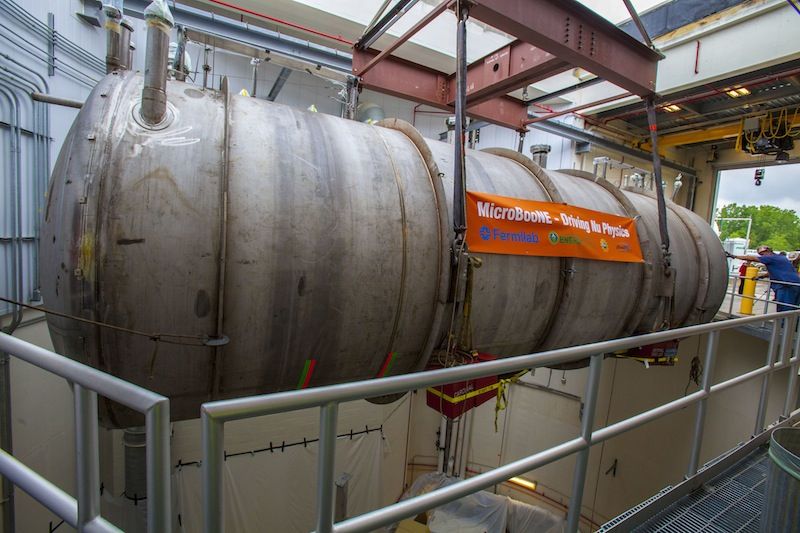
A completely new subatomic particle — one so reclusive and strange that it passes undetected through ordinary matter — could be lurking in the universe.
If so, a detector set to turn on later this year could find the first convincing evidence for the particle, called a sterile neutrino. The new experiment, whose 30-ton detector was recently lowered into place at Fermi National Accelerator Laboratory in Illinois, will look for traces of this elusive particle transforming into another type of neutrino.
Unlike the Higgs boson, the particle thought to explain why other particles have mass and which most physicists predicted should exist for decades, sterile neutrinos would be in the realm of completely unknown physics that only some physicists believe exist, said Bonnie Fleming, the experiment's spokeswoman and a physicist at Yale University. "It would be completely revolutionary," Fleming said. [Wacky Physics: The Coolest Little Particles in Nature]
Ghostly particles
Neutrinos are miniscule, nearly massless subatomic particles that form during nuclear reactions in the hearts of stars, supernovae and other explosive cosmic events. Though trillions of neutrinos pass through our bodies every second, they almost never interact with other matter, giving them the nickname "ghost particles."
The known neutrinos come in three different types, or flavors — electron, muon and tau — and in the last 15 to 20 years, scientists have learned that those flavors oscillate, or change into one another, with a certain frequency. (During collisions, electron neutrinos can also turn into electrons, muon neutrinos can transform into muons, and tau neutrinos can turn into tau leptons, particles that are similar to electrons.
But a few hints suggest there could be a totally new type of neutrino out there. For instance, experiments in the 1990s to detect neutrinos from the sun found possible evidence that electron neutrinos were disappearing. Another experiment designed to probe neutrino oscillation found extra electron neutrinos appearing. One explanation for these anomalies is that the neutrinos were morphing into an intermediate particle called a sterile neutrino.
Sign up for the Live Science daily newsletter now
Get the world’s most fascinating discoveries delivered straight to your inbox.
If such sterile neutrinos exist, they would interact only with matter through the incredible weak force of gravity, making direct detection impossible, Fleming told Live Science.
Hunting sterile neutrinos
So starting late this year or early in 2015, Fleming and her colleagues will look for indirect evidence of sterile neutrinos. The experiment, called MicroBooNE, will shoot a beam of pure muon-flavored neutrinos 0.3 miles (0.5 kilometers) through a 30-ton metal tank filled with argon. Though most of these ghost particles will travel through the argon unchanged, some will occasionally change flavor to an electron neutrino, tau neutrino — or possibly a sterile neutrino.

Some fraction of these neutrinos will then go on to collide with the nuclei of argon atoms in the detector.
"They will shatter that nucleus, and parts of that nucleus will go everywhere," said Matt Strassler, a physicist at Harvard University who was not involved in the study. As part of the collision, electron neutrinos will sometimes morph into electrons, Strassler added.
The detector then identifies where, when and what type of particles were created by analyzing the trail left by ionized, or charged, particles after the collision.
Because the researchers know how often electron neutrinos should convert into electrons during such collisions, any deviation from expectations could be a sign that a muon neutrino morphed into an intermediate sterile neutrino, then into an electron neutrino, and finally into an electron.
Longshot physics
Though the discovery of a sterile neutrino is a possibility, it's not likely, Strassler said.
MicroBooNE is working to clarify tantalizing hints in data from a precursor experiment called MiniBooNE, but there's a good chance that MiniBooNE's "dirty measurement" is picking up other processes instead, Strassler said.
Even if the new experiment uncovers something strange, there's no guarantee sterile neutrinos caused the signal, rather than some other completely different interaction, he said.
"There's a very small — not zero — chance that they're actually going to uncover one of the great secrets of the universe," Strassler told Live Science.
Follow Tia Ghose on Twitter and Google+. Follow Live Science @livescience, Facebook & Google+. Original article on Live Science.

Tia is the managing editor and was previously a senior writer for Live Science. Her work has appeared in Scientific American, Wired.com and other outlets. She holds a master's degree in bioengineering from the University of Washington, a graduate certificate in science writing from UC Santa Cruz and a bachelor's degree in mechanical engineering from the University of Texas at Austin. Tia was part of a team at the Milwaukee Journal Sentinel that published the Empty Cradles series on preterm births, which won multiple awards, including the 2012 Casey Medal for Meritorious Journalism.











